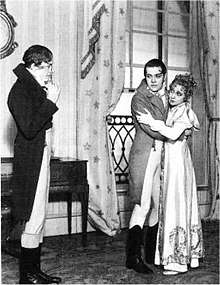Gladys Calthrop
Gladys Edith Mabel Calthrop (née Treeby; 29 March 1894 – 7 March 1980) was an artist and leading British stage designer. She is best known as the set and costume designer for many of Noël Coward's plays and musicals.[1]

Life and career
Calthrop was born in Ashton, Devon, the daughter of Frederick Theophilus Treeby and his wife Mabel. She was educated at Grassendale School, Southbourne, West Sussex. Her parents sent her to a finishing school in Paris, and she returned married to Army captain Everard E. Calthrop, from Norfolk. The couple had a son, Hugo, whose care Calthrop entrusted mostly to her mother. He was later killed in Burma Campaign. She was soon separated from her husband (she had lesbian relationships thereafter) and studied art at Slade School of Fine Art.[1]
Calthrop was introduced to Noël Coward by Mrs. Astley Cooper while on holiday in Italy in 1921.[2][3] She soon became a close friend of Coward's, and she commenced her theatre career in November 1924 with her design for his The Vortex, staged at the Everyman Theatre in Hampstead.[4] As she later recalled: "It was the first play I had ever designed so I was terribly excited, though there was nowhere to paint the sets except outside the theatre in Hampstead High Street, and the costumes all had to be made in a kind of basement there."[5]
She stayed in New York after travelling there for the Broadway production of The Vortex, becoming Artistic Director for Eva la Galliene's Civic Repertory Theatre,[6] for whom she directed John Gabriel Borkman on Broadway in 1926. Her designs for Broadway included The Cradle Song (1927), This Year of Grace (1928), Bitter Sweet (1929), Autumn Crocus (1932), Private Lives (1931), Design for Living (1933), Conversation Piece (1934), Point Valaine (1935), Tonight at 8.30 (1936), Excursion (1937), Dear Octopus (1939) and Set to Music (1939).
Calthrop continued to work as a designer in Britain until 1964.[7] She also designed some films, including four Coward adaptations, in the 1940s.[6] In 1940 she published her first and only novel, Paper Pattern. During World War II, she served in the Mechanical Transport Corps.[3] She also illustrated the Noël Coward Song Book (1953). She died at the age of 85.[3]
Stage works
The dates given are for the West End productions unless otherwise specified:
|
|
Filmography
- In Which We Serve (1942)
- This Happy Breed (1944)
- Brief Encounter; Blithe Spirit (1945)
- The Fighting O'Flynn (1949)
- The Astonished Heart (1950)
References
- "Mrs Gladys Calthrop – Artist and Stage Designer". The Times. The Times Digital Archive. 11 March 1980.
- Hoare, Philip. Noël Coward, A Biography. Sinclair-Stevenson, 1995. ISBN 1-85619-265-2, pp. 85–86
- "Mrs Gladys Calthrop – Artist and stage designer", The Times, 11 March 1980, p. 14
- Who's Who in the Theatre, 14th edition, Pitman (1967)
- Morley, Sheridan. A Talent to Amuse: a Biography of Noël Coward, p. 77, Heinemann (1969, revised 1974) ISBN 0-434-47895-4
- Port, Raymond. "Gladys Calthrop". Biographies, Matt & Andrej Koymasky website, accessed 29 May 2011
- "Gladys Calthrop". University of Calgary libraries, accessed 29 May 2011
- The Bröntes is by Margaret Webster.
External links
- Gladys Calthrop at the Internet Broadway Database
- Gladys Calthrop on IMDb
- "Gladys Calthrop". Images at the National Portrait Gallery
- Image of Calthrop and Coward, 1924
- Painting by Calthrop